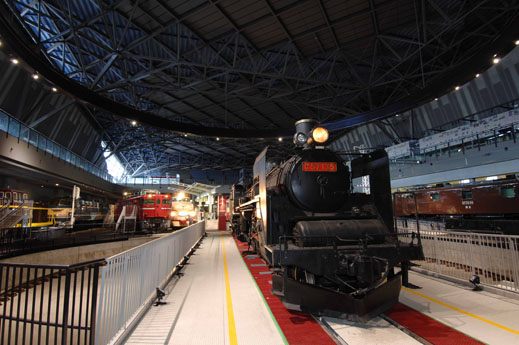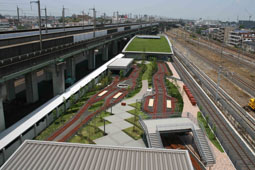 |
| The C57 steam locomotive, built in 1937, on the main floor of the Railway Museum. |
When Japan Railways shut down its Transportation Museum in downtown Tokyo in May 2006, trainspotters throughout the land mourned its passing. Granted, the old building, built in 1936 next to one of Japan's first railway stations, had grown too cramped for its collection of boats, planes, buses, and of course steam locomotives, diesels and electric trains of all persuasions. But the place had a certain charm. A basement tunnel led to the remains of the old Manseibashi station, once the eastern terminus of the Chuo trunk line before it was extended a mile further into Tokyo Central. Chuo Line expresses still race past the weed-grown Manseibashi platform (closed since 1943), but nothing is left of the museum that sat beside it for so many years.
The good news is that JR has amply compensated for the loss with a glorious new museum devoted entirely to trains. Though the recently opened Railway Museum will warm the hearts of SL fanatics the world over, it is a pity that room was not made for the old place's motley collection of other modes of transport, which ranged from ocean-going sailing ships to rickshaws and three-wheel trucks. Those, we are told, are in storage somewhere.
But meanwhile the Railway Museum, which opened in fall 2007 on land formerly occupied by a JR repair shed next to the Tohoku trunk line in Omiya, just north of Tokyo, offers trains, trains and more trains. I recommend bringing a hardcore trainspotter along, as I did. My friend Chris hails from the U.K., the motherland of trainspotting, and true to form he regaled me with more details about Japanese steam locomotive technology than I really needed. Still, his enthusiasm was contagious.
JR has cleverly imported and improved on some of the most popular exhibits from the old museum, notably a vast room-size diorama -- with auditorium seating -- of model trains chugging through a mixed urban-rural landscape. Just as big a draw are several simulators replicating the engineer experience on various train models, notably that of Japan's first SL. On a Sunday afternoon, the diorama and simulators attracted long lines of kids and their patient (or perhaps just as eager) parents, and my friend was nearly reduced to tears when it became clear that the queue for the SL simulator was prohibitively long.
The real spectacle, however, is the main floor, a hall as big as a railyard (with its own turntable) that holds 36 impeccably preserved engines and carriages of all eras -- ranging from Locomotive No. 1, which plied Japan's first line between Shinbashi and Yokohama in 1872, to the first bullet train, whose nose has graced so many travel posters since its debut in 1964, to the latest energy-conserving electric commuter cars. (A separate room is devoted solely to the seemingly endless permutations in bullet train design, ongoing as we speak.)
Nearly as overwhelming is the 75-meter-long timeline of Japanese railroad history that extends along an entire wall of this hall. Unfortunately it will prove edifying only for those who can read Japanese. Though English explanations are provided for key exhibits, one wishes that the museum were a little more foreigner-friendly, considering the hordes of non-Japanese railway buffs who would readily converge on it if given a little incentive.
Not to be missed is a trip to the rooftop observation deck, located hard by the Tohoku Shinkansen tracks, from which you can observe real bullet trains whipping past at frequent intervals. Indeed, it's the ideal location for a railway museum.
|
|
|
|
|
|
 |
|
|
|
| The diorama room, with up to 20 trains running on 1400 meters of HO gauge track. |
|
The "running zone" where visitors can drive mini-trains as bullet trains whiz by on real tracks on either side. |
|
|
|
| Images courtesy of The Railway Museum. Reproduction without permission is expressly prohibited. |
|